As an Amazon Associate, we earn from qualifying purchases with no additional costs for you.
Japanese knives are quality kitchen tools that can be expensive, which is why these knives are bought individually rather than as a set. One of the best Japanese kitchen knives to start with is the versatile gyuto. Sourcing quality knives can be a challenge for knife buyers, so we have recommended some options that may help with your selection.
Gyuto knives are versatile Japanese knives used for various kitchen tasks, from chopping fruits, vegetables, and herbs to cutting meat and fish. The gyuto is the ideal first Japanese kitchen knife for your collection because of its multipurpose function, similar to the Western-style chef’s knife.
Choosing the best knife you can afford within your budget is the best strategy to find the right gyuto for your kitchen. We have selected four gyuto knives as possible candidates to add to your knife collection with confidence.
If you are interested in checking out the best Gyuto knife made by Hayate Yoshihiro we recommend and personally use you can find it by clicking here (Amazon link).

Where To Buy Gyuto Knives
Gyuto knives are the Japanese kitchen knife equivalent of the Western chef’s knife. Like the chef’s knife, the gyuto is one of the most versatile knives in the kitchen and is the go-to knife for many kitchen tasks.
Consequently, the gyuto is often the first Japanese kitchen knife many people acquire. Where is the best place to buy a quality gyuto to ensure you get a quality product that will serve you well in the kitchen?
The best place to look for a quality gyuto knife is from a reputable Japanese kitchen knife manufacturer. Genuine Japanese knife makers are located in Japan, so unless you go on a quest to Japan to buy your knives, the best place to source these knives is online.
However, purchasing knives online is not without risk, which requires that some investigation into the supplier and the reviews from previous customers are taken into consideration before buying your gyuto online.
What To Look For When Buying Gyuto Knife
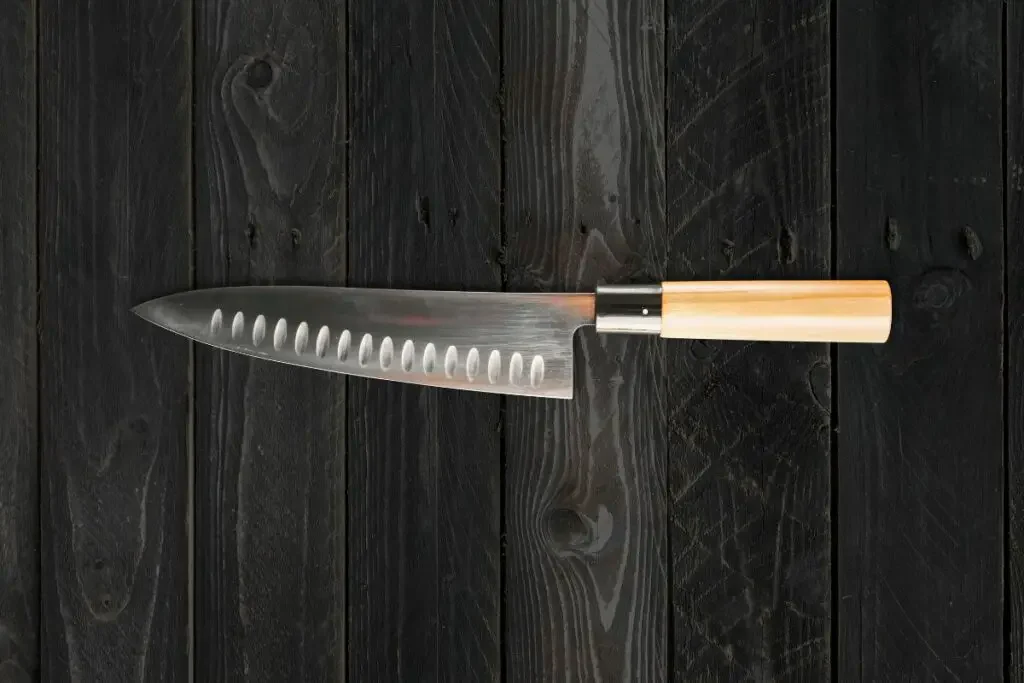
Buying a gyuto is the same as purchasing any other knife, which requires examining certain characteristics to ensure it meets your needs and has the quality you expect from the purchase.
Some key aspects of a gyuto to look at before purchasing include the following.
Gyuto Knife Maker Reputation
This aspect is probably one of the highest priorities when buying Japanese knives. Many knives offered online are not from authentic Japanese knife makers and do not deliver a high-quality product.
Most authentic Japanese knife makers take pride in their work and focus on delivering quality products that reflect well on their company and Japanese culture.
Performing basic research on a knife brand and looking for reviews from customers who have purchased the knife are good strategies for understanding the quality of the knives from the manufacturer.
What Steel Is Used In The Gyuto?
Most genuine Japanese Gyuto knives will be made from Japanese high-carbon steel or from stainless steel called VG-10, which can only be sourced in Japan.
The type of steel used in the knife can indicate the blade’s quality and whether the knife is an authentic Japanese knife or a lookalike.
Some knives are made from Damascus steel, which is fine, but the core steel, which represents the cutting edge, must be good quality steel, such as Japanese high-carbon or stainless steel.
The blade is the part of the knife that will determine the effectiveness of the knife and the user experience. The type of steel used in the blade is, therefore, a good indicator of the quality of the knife and how the knife will perform.
Is The Gyuto Single Or Double Bevel?
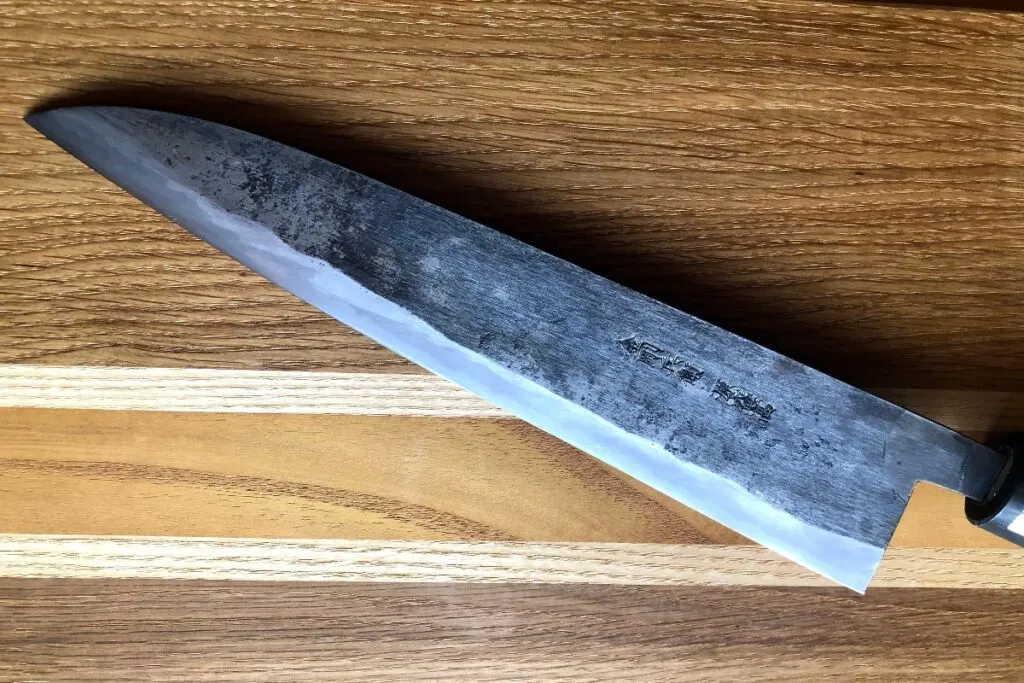
Some gyuto knives come with a single bevel design, while others have a double bevel edge. If you are new to Japanese knives, the best blade design to choose is a double-bevel design.
On a single-bevel blade, one side is flat or has a slight hollow grind, while the opposite side tapers down to the blade’s cutting edge.
On a double-bevel blade, both sides of the blade taper to the fine cutting edge of the steel. Double-bevel blades are easier to maintain and sharpen than single-bevel blades, making double-bevel gyuto knives the better choice for most people.
What Type Of Handle is On The Gyuto?
The handle on the knife will affect the comfort of the knife in your hand and the confidence with which you use the knife.
A good handle on a knife will improve the knife’s safety and prevent fatigue when the knife is used for long periods.
You essentially have two handle choices on a gyuto knife: a traditional Wa-style handle or a Western-style handle. Some Japanese knife makers put Western-style handles on some of their knife ranges to make them more appealing to this market. Other manufacturers stick to the traditional Wa-style handle, which can have an octagonal, D-shaped, or oval cross-section.
The handle material should be a durable wood on a genuine Japanese gyuto or can be a synthetic material on a modern variation of the gyuto style.
What is Your Budget For Your Gyuto?
Japanese kitchen knives are expensive for a reason, which may cause you to be tempted by a deal that seems really cheap. These “cheap” Japanese knives are not usually worth the money and are not authentic Japanese knives made with top-quality steel.
This does not mean you need to break the bank to buy your gyuto. Some knives have different price points, allowing people with various budgets to own a gyuto.
Buy the best knife you can within your budget to ensure you get a quality knife that will last for many years and perform the way you expect in the kitchen.
Some knives are priced lower due to different steels used in manufacturing, different manufacturing methods, and cheaper handle materials.
TIP: Both funayuki and gyuto are considered to be multipurpose Japanese knives. Check out the main differences between these two Japanese knives in the article below:
Funayuki Vs. Gyuto: The 5 Essential Differences
What Is A Gyuto Knife Good For?
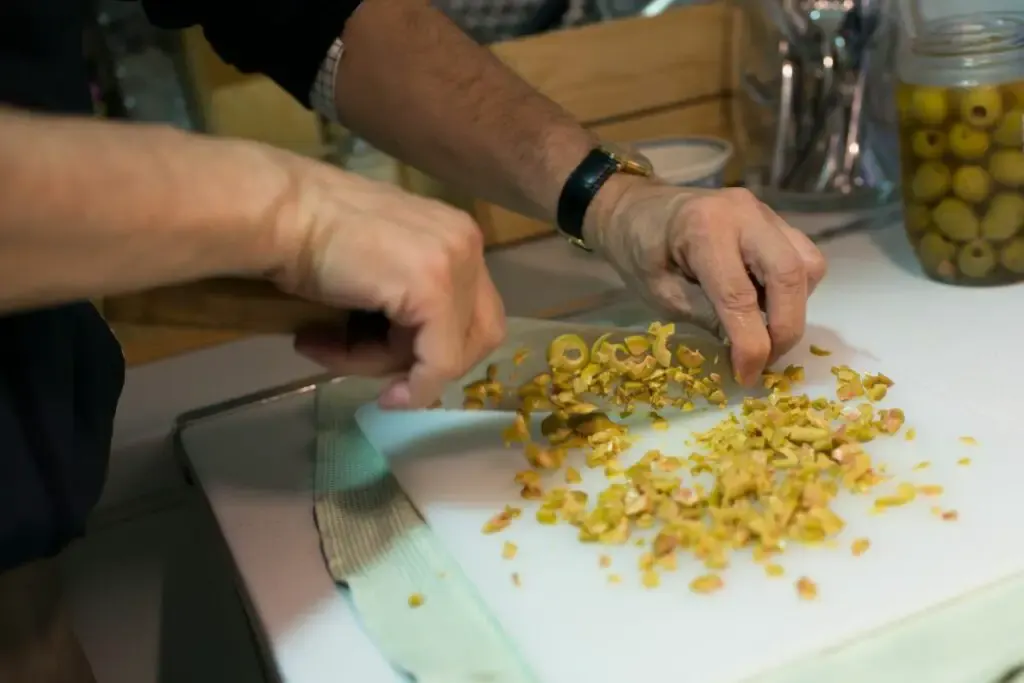
A gyuto is the Japanese equivalent of the versatile Western chef’s knife. Most Japanese kitchen knives are designed for a specific kitchen task, but the gyuto is a multipurpose knife suitable for many kitchen tasks.
Gyuto’s can be used with various cutting techniques and can process meat, fish, fruit, vegetables, and herbs. The knives can be used for push and pull cuts, vertical slicing, and limited rocking chopping motions for small vegetables or herbs.
The gyuto comes in a variety of sizes and can measure anywhere from 7-inches to 14-inches or 180mm to 360mm. The most common length gyuto knives most people find comfortable are lengths between 7 inches and 12 inches or 180mm and 300mm.
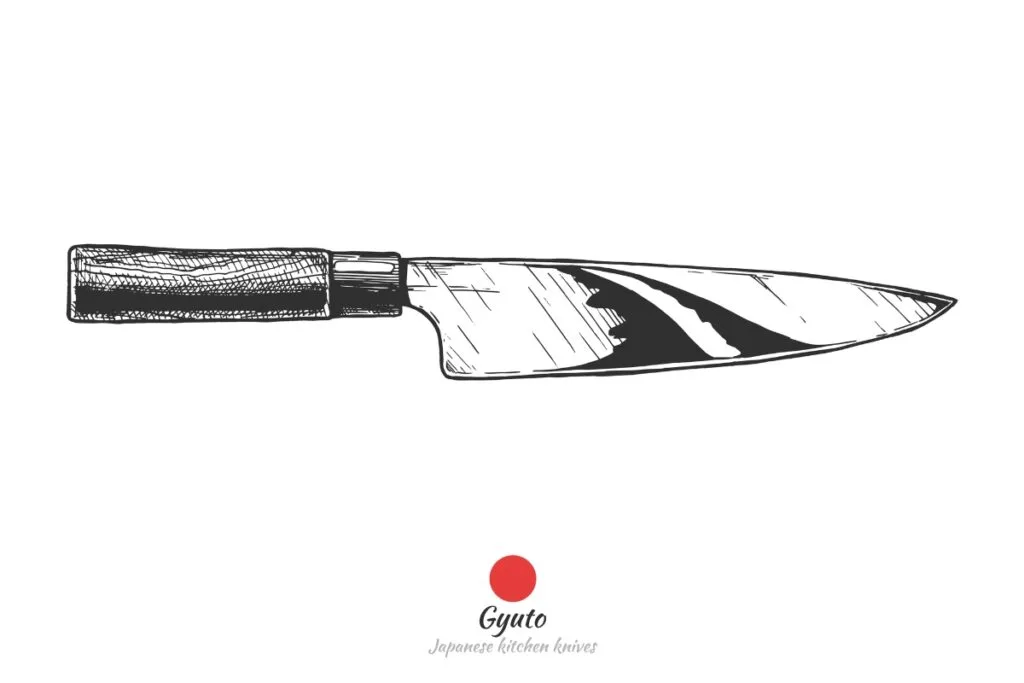
Best Gyuto Knives Under $200
When you buy a gyuto knife, you will use it frequently in the kitchen due to its multipurpose function. It makes sense to buy the best gyuto you can since you will be reaching for this knife more than any other in the kitchen, and you want the knife to last.
Buying your gyuto as an individual knife rather than as a set will allow you to get a better knife for your money and spend less money.
We have selected two gyuto knives that will cost less than $200 but still offer an exceptional knife that you will find a pleasure to use in your kitchen!
Best Pick: Yoshihiro VG-10 Hammered Damascus Gyuto
Our first recommendation is the Yoshihiro VG-10 Hammered Damascus Gyuto. Hayate Yoshihiro is a well-known Japanese knife manufacturer that produces high-quality Japanese kitchen knives.
The Yoshihiro VG-10 Hammered Damascus Gyuto (Amazon link) is made from 46 layers of VG-10 stainless steel. This stainless steel incorporates Japanese steel, which allows it to be hardened to a higher degree than Western stainless steel types.
This Yoshihiro Gyuto has a 7-inch or 180mm blade, making it one of the shorter gyuto variants but giving it an agility that is less common with longer blades.
The cutting edge has a slight curve, allowing the typical rocking motion cut that many chefs like to use to chop smaller ingredients quickly.
The hammered texture on the blade serves to break the surface tension between the blade and the ingredients, preventing the food from sticking to the sides of the knife.
Yoshihiro created this gyuto in the traditional Japanese style, with the Wa-handle in the traditional octagonal shape and made from Ambrosia wood. The dense wood is resistant to soaking up food juices but lightweight enough to provide exceptional balance to the knife.
A wood saya, a traditional sheath made from wood, is included with the knife so you can protect the blade when storing the knife.
This knife is an exceptional gyuto that any chef would be happy to own and use in the kitchen!
Alternative: Shun Cutlery Sora 8-Inch Gyuto-Style Knife
Shun Cutlery is another authentic Japanese kitchen knife manufacturer that specializes in top-quality knives. Some of their knives are created in the traditional Japanese style, while others deviate from tradition in certain aspects.
Our second gyuto selection in the under $200 category is the Shun Cutlery Sora Gyuto (Amazon link), which is an 8-inch or 200-mm blade.
The steel used in the knife is layered steel with 420J stainless steel as the outer cladding and VG-10 stainless steel as the central core, providing the cutting edge for the knife.
This steel layering is known as San Mai, which means three layers. The central VG-10 core is sandwiched between two layers of 420J steel.
The use of stainless steel throughout the blade means the knife is easier to clean and maintain since it is corrosion and stain-resistant.
The handle is where the Shun Sora deviates from traditional Japanese design. The handle is made from a textured PP/TPE polymer blend and follows more Western lines than traditional Wa-handles.
However, the modern handle does not detract from the knife and remains comfortable and a pleasure to use.
TIP: Are you looking for the best knife for cutting meat, bones, and fish? Check out the best suitable Japanese knives for this special task in the article below:
Best Japanese Knives For Cutting Meat, Bones & Fishes
Best Gyuto Knives Under $100
If spending more than $100 on a gyuto is too much for your present budget, then we have some recommendations that may be more suitable to your price point and allow you to own a great knife with all the characteristics of Japanese kitchen knives.
The knives in the category under $100 are also quality knives manufactured by authentic Japanese kitchen knife makers, but the design of the knives and the materials used to allow them to be marketed at a lower price.
Best Pick: Tojiro DP Gyutou
Tojiro is a Japanese knife manufacturer that produces a wide range of kitchen knives in both the traditional Japanese style and more Westernized designs.
Traditional-style Japanese knives involve more handcrafted components, which increases the labor required to produce the knives and causes a corresponding increase in cost.
Knives made with a Western influence can be made with automated processes that are faster and cheaper, producing a more affordable knife.
The Tojiro DP Gyuto (Amazon link) is a knife produced in the Western style, which carries a lower price tag. This gyuto has an 8.1-inch or 210mm blade and is made with a VG-10 stainless steel core and stainless steel cladding.
The Tojiro DP Gyuto is a full tang knife, and the handle is a Western style, made from reinforced laminate, making it durable and tough.
The knife features an integrated metal bolster, which prevents dirt and food particles from accumulating between the blade and the handle.
If you are unfamiliar with Japanese-style knife handles, the Western-style handle on this knife offers a better option for a first-time Japanese knife buyer.
Alternative: Misono Molybdenum Gyuto
Our second recommendation for a gyuto knife under the $100 price point is a knife created by Misono from Seki-city in the Gifu Prefecture in Japan.
The Misono Molybdenum Gyuto (Amazon link) is an 8.2-inch or 210mm blade made from stainless steel with a high molybdenum content. The high levels of molybdenum add strength to the steel, allowing for more durability and hardness in the steel to support a fine, sharp edge.
The stainless steel is corrosion-resistant, making the knife easier to clean and maintain. It has a double bevel blade, making it easier to sharpen and suitable for left or righthanded people.
The blade is full tang, and the handle is a Western-style shape and design, making for a more familiar feel for some people who prefer this handle shape.
Misono makes some of the most affordable Japanese kitchen knives, making it a popular brand for knife buyers on a budget!
BTW: If you are interested in buying the best cutting board, you can find our recommendations below:
- The best overall: Virginia Kitchen Boys Cutting Board (Amazon link). This fantastic cutting board is made from sustainable walnut wood from the United States and brings almost perfect safety when cutting with your knives.
- Alternative: Yoshihiro Cutting Board (Amazon link). Professional traditional Japanese cutting board that chefs around the world use.
- Cheaper option: Shun Cultery Cutting Board (Amazon link). Another Japanese cutting board stands out, especially for its simplicity and affordable price.
Care and Maintenance of Gyuto Knives
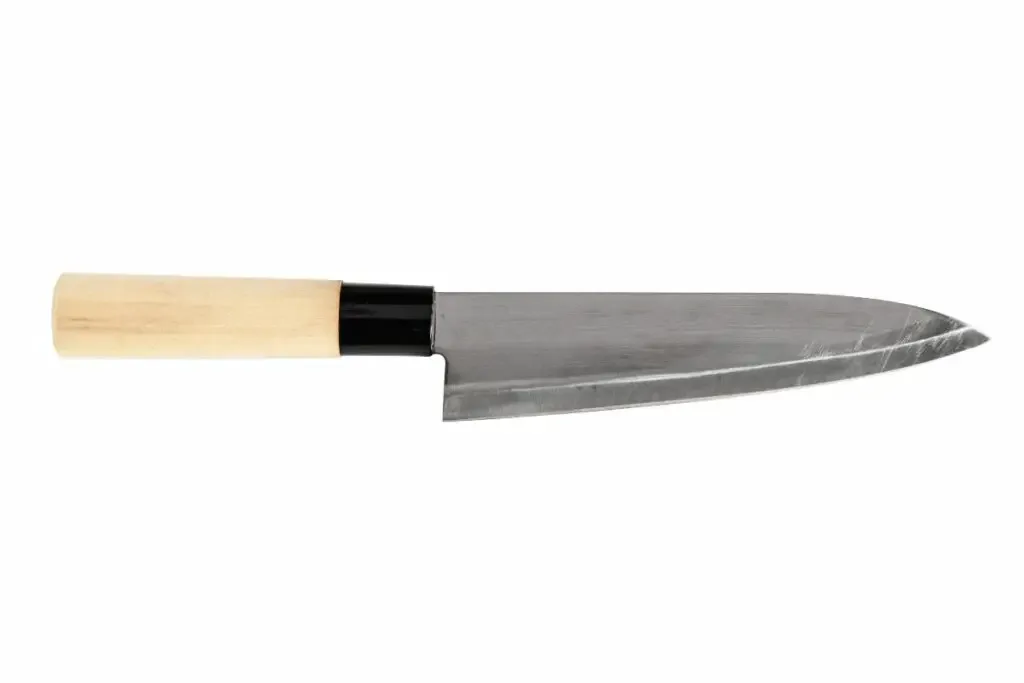
Maintaining your gyuto knife is not just about preserving its appearance; it’s crucial for ensuring its longevity, performance, and safety. Regular care and maintenance can significantly extend the life of both high-end and more affordable gyuto knives.
While more expensive knives often use higher quality materials that can retain sharpness longer and resist wear, they still require proper care to maintain these qualities. Cheaper knives, on the other hand, may demand more frequent maintenance but can also last longer and perform well with the right care.
Cleaning Your Gyuto Knife
Hand Wash Only: Always hand wash your gyuto knife with warm water and a mild detergent. Dishwashers can be too harsh and may damage the blade and handle.
Immediate Cleaning: Clean the knife immediately after use to prevent food acids from damaging the blade.
Dry Thoroughly: After washing, dry the knife immediately with a soft towel to prevent rust, especially for high-carbon steel knives.
Sharpening Your Knife
Regular Honing: Use a honing rod regularly to maintain the knife’s edge. This doesn’t sharpen the blade but realigns the edge, keeping it sharp longer.
Sharpening Technique: Use a whetstone for sharpening. Start with a coarser grit and move to a finer grit. The angle and technique may vary slightly between cheaper and more expensive knives due to differences in blade hardness and steel quality.
Professional Sharpening: Consider professional sharpening annually, especially for high-end knives, to maintain optimal blade geometry.
Storage Solutions
Knife Block or Magnetic Strip: Store your gyuto knife in a knife block or on a magnetic strip. This prevents the blade from coming into contact with other utensils, which can dull the edge.
Avoid Loose Storage: Never store your gyuto knife loosely in a drawer where it can get banged up against other utensils.
Use Blade Guards: If you must store your knife in a drawer, use a blade guard to protect its edge.
General Maintenance Tips
Avoid Hard Surfaces: Cutting on hard surfaces like glass or metal can dull your knife quickly. Use a wooden or plastic cutting board instead.
Handle with Care: Be mindful of the knife’s balance and weight, especially for high-end knives, which often have a more delicate balance.
Regular Inspection: Regularly inspect your knife for any signs of wear or damage, such as chips or bends in the blade.
Oil the Blade: For high-carbon steel knives, occasionally oil the blade to prevent rust.
Differences in Maintenance: High-end gyuto knives often require more delicate handling and storage due to their finer blade construction and materials. Cheaper knives, while more robust, may need more frequent sharpening and honing.
Proper care and maintenance of your gyuto knife, whether it’s a budget-friendly option or a high-end model, are essential for its longevity and performance.
By following these guidelines, you can ensure that your knife remains a reliable and efficient tool in your culinary arsenal for years to come. Remember, a well-maintained knife is not just a tool but an investment in your cooking experience.
Conclusion
Using a Japanese kitchen knife is an experience that is often a turning point for knife users. Once you have felt these knives’ balance, precision, and sharpness, it is difficult to return to a different knife.
The gyuto is the multipurpose Japanese kitchen knife equivalent to the Western-style chef’s knife and is an excellent option for those who are looking for their first Japanese knife experience!
TIP: Patience, attention to detail, and some basic knowledge will get you sharpening your Japanese knife like a pro in no time! Check out the complete step-by-step guide in the article below:
Sharpen Japanese Knife Like A PRO (Single & Double Bevel)

